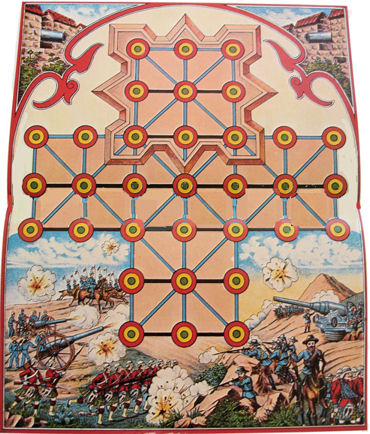The game on this Webpage comes from the book Great Board Games, compiled by Brian Love, NY: Macmillan Publishing Co., Inc., 1979, 80 pages. This interesting book includes printed reproductions of 43 boxed board games published in a number of countries in the 19th century and the early years of the 20th century. The book is physically large (about 50cm x 40cm) and for the most part includes playable reproductions of these games. Moreover, included are cardboard playing pieces for each game, as well and information and playing instructions for each game.The Museum has thus added these reproduced games to its collection.

The photograph on the left of the game box top was scanned from the book. According to Brian Love, the game was:
...printed in Bavaria at the turn of the [19th] century and imported into France with the imprint of Saussine Editions Paris.
The graphic illustrates a battle between the two opposing forces in the Boer War - the troops of Great Britain (on the right) - and the two Boer allied armies, the troops of the South African Republic (the Transvaal) with the troops of the Orange Free State (on the left).
The game commemorates the siege of Ladysmith, a town in the Transvaal in which the British were besieged for 118 days by the Boer Allies for a period of four months in 1899.

The gameboard, which appears on pages 28-29 of the book was photographed, digitized, and edited so that it could appear on this Webpage. The size of the board in the book is 39cm x 31cm, but may have been reduced from the original for that publication. Given the shape of the box, the board probably originally folded in half to be placed in the box for storage.
The lower part of the board illustrates a number of British troops on the left engaged in combat with the Boer troops on the right. The matrix on the board is a typical Asalto design of 33 points, with a "fort" of nine points at the top of the board.
The game is played like all the other Asalto games, the only difference is that this game has the theme regarding the battle of Ladysmith. As in the other Asalto games, the two "besieged" pieces occupy the fort - representing the British. Twenty-four Boers attempt to take the fort from the British by occupying the nine points of the fort. The Boers may only move forward toward the fort. They cannot jump. They may move up or along any diagonal line to the fort and across the outside edge of the fort. Within the fort they may not move across the back two lines. The two British pieces may move forward, backward, sideways, or diagonally along any line, and in addition may jump over any Boer when there is an vacant hole beyond the Boer. When a British piece jumps over a Boer to a vacant hole, that Boer is removed from the game. British pieces MUST jump out of the fort when an opening makes it possible. A British piece may "capture" more than one attacker on a move, when the number of vacant holes makes this possible.
The game ends when the Boers occupy the nine places in the fort, or when the British have captured fifteen attackers. According to Brian Love, the British have win the game if they succeed in retaining a soldier within the stronghold, or if their enemies have not occupied all nine points of the stronghold. He further states that the game is undecided if the defenders have left the fortress and cannot go back, or if the enemy cannot occupy it entirely.
Last update March 2, 2010